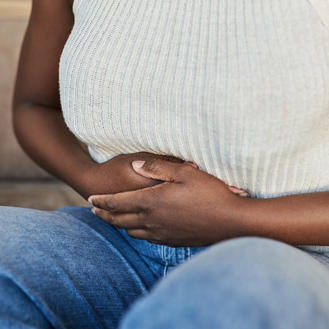
October 25, 2021
By Anna Owen, MS4, Drexel University College of Medicine
Endometriosis is the presence of endometrial tissues outside the uterine cavity. This estrogen-dependent disease has its highest incidence in women aged 25-29 years and affects about 10% of reproductive-age women. In women with pelvic pain, 70-90% have endometriosis. Similarly, women who struggle with infertility are found to have endometriosis 21-40% of the time. Women are at a 6-fold increased risk of endometriosis if a first-degree relative is diagnosed with a severe form of the disease. Early menarche (first period), late menopause, low body mass index (BMI), nulliparity, prolonged menstruation (>5 days), shorter lactation intervals, and shorter menstrual cycles (<28 days) also indicate increased risk of disease development.
The most widely accepted theory of disease development involves retrograde menstruation. This is when menstrual tissue is refluxed from the uterus back through the fallopian tubes and enters the pelvic cavity, embedding itself in other tissues instead of leaving the uterus through the cervix. Commonly affected sites are areas closest to the fallopian tubes and include: the ovaries (55%), anterior cul-de-sac (35%), posterior broad ligaments (35%), posterior cul-de-sac (34%) and uterosacral ligaments (28%). Three distinct clinical presentations are often described including: endometrial implants on the peritoneum, endometrial lined ovarian cysts called “chocolate cysts” or endometriomas (pictured in link below), and endometriotic nodules found between the rectum and vagina.
Some patients with endometriosis are asymptomatic. Others suffer the symptoms of debilitating pelvic pain, dysmenorrhea (pain with menstruation), dyspareunia (pain with sex), bleeding after sex, menorrhagia (increased menstrual flow) and decreased fertility. Patients also have nonspecific complaints such as chronic low back pain or diffuse abdominal pain. These symptoms can be investigated in several ways, and it takes an average of 11.7 years to arrive at the diagnosis of endometriosis. On physical examination some patients will have normal findings. Other patients will be tender, have limited motion of the uterus and/or ovaries, and may have masses on the ovaries.
The diagnosis of endometriosis is based on clinical findings, physical examination findings and the investigation of other possible diagnoses. Diagnosis can be confirmed by direct detection of extrauterine endometrial tissues via surgical investigation with laparoscopy. If ovarian cysts are suspected, transvaginal ultrasound can be used for confirmation.
Treatment of endometriosis starts conservatively with non-steroidal anti-inflammatory drugs (NSAIDs) for symptom management. Additionally, combination estrogen/progestin contraceptives, progestin-only contraceptives and hormone therapies can be used to control symptoms provided fertility is not desired. If laparoscopy is used to confirm diagnosis, surgical ablation of tissue deposits and excision of endometriomas can be performed to relieve pain symptoms and improve fertility. If no future pregnancy is desired, patients can undergo hysterectomy to treat symptoms.
Photos:
Sources/Resources: